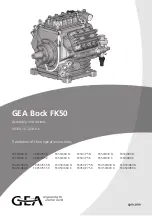
C6.2.26/1013-1116/E
23
5.5 Initial start-up
CAUTION
Oil dilution! Bearing malfunction!
It is important to ensure that new
compressors are not subjected to liquid abuse. Turn the crankcase heater on
12 hours before starting the compressor.
CAUTION
High discharge pressure operation! Compressor damage!
Do not use
compressor to test opening set point of high-pressure cut-out. Bearings are
susceptible to damage before they have had several hours of normal
running in.
Liquid and high pressure loads could be detrimental to new bearings. It is therefore important to
ensure that new compressors are not subjected to liquid abuse and high-pressure run tests. It is
not good practice to use the compressor to test the high-pressure switch function on the
production line. Switch function can be tested with nitrogen prior to installation and wiring can be
checked by disconnecting the high-pressure switch during the run test.
5.6 Rotation direction
Scroll compressors, like several other types of compressors, will only compress in one rotational
direction. Direction of rotation is not an issue with single-phase compressors since they will
always start and run in the proper direction. All three-phase compressors will rotate in either
direction depending upon the phasing of the power. Since there is a 50-50 chance of connecting
power in such a way as to cause rotation in the reverse direction
, it is important to include
notices and instructions in appropriate locations on the equipment to ensure proper
rotation direction when the system is installed and operated
.
Observing that suction pressure drops and discharge pressure rises when the compressor is
energized allows verification of proper rotation direction. There is no negative impact on
durability caused by operating three-phase Copeland Scroll compressors in the reversed
direction for a short period of time (under one hour) but oil may be lost. Oil loss can be prevented
during reverse rotation if the tubing is routed at least 15 cm above the compressor. After several
minutes of operation in reverse, the compressor's protection system will trip due to high motor
temperature. The operator will notice a lack of cooling. However, if allowed to repeatedly restart
and run in reverse without correcting the situation, the compressor will be permanently
damaged.
All three-phase scroll compressors are identically wired internally. Therefore, once the correct
phasing is determined for a specific system or installation, connecting properly phased power
leads to the identified compressor terminals will ensure proper rotation direction.
5.7
Starting sound
During the very brief start-up, a clicking sound is audible, resulting from initial contacting of the
spirals and is normal. Due to the design of the Copeland Scroll, the internal compression
components always start unloaded even if system pressures are not balanced. In addition, since
internal compressor pressures are always balanced at start-up, low-voltage starting
characteristics are excellent for Copeland Scroll compressors.
5.8
Deep
vacuum
operation
CAUTION
Vacuum operation! Compressor damage!
Scroll compressors should
never be used to evacuate a refrigeration or air-conditioning system.
The scroll compressor can be used to pump down refrigerant in a unit as long as the pressures
remain within the operating envelope. Low suction pressures will result in overheating of the
scrolls and permanent damage to the compressor drive bearing.
5.9
Shell
temperature
The top shell and discharge line can briefly but repeatedly reach temperatures above 177°C if
the compressor cycles on its internal protection devices. This only happens under rare
circumstances and can be caused by the failure of system components such as the condenser
or evaporator fan or loss of charge and depends upon the type of expansion control. Care must
S
afet
y
inst
ru
ctio
n
s
P
ro
d
u
ct
d
es
cr
ipt
ion
Inst
all
atio
n
E
lec
tr
ica
l
con
n
ec
tion
S
tar
ting
up
&
o
p
er
atio
n
Ma
int
enan
c
e
&
repai
r
T
ro
u
b
le
-
sho
o
ting
Dismant
ling
&
d
ispo
sa
l
Ref
er
en
ce
s











































